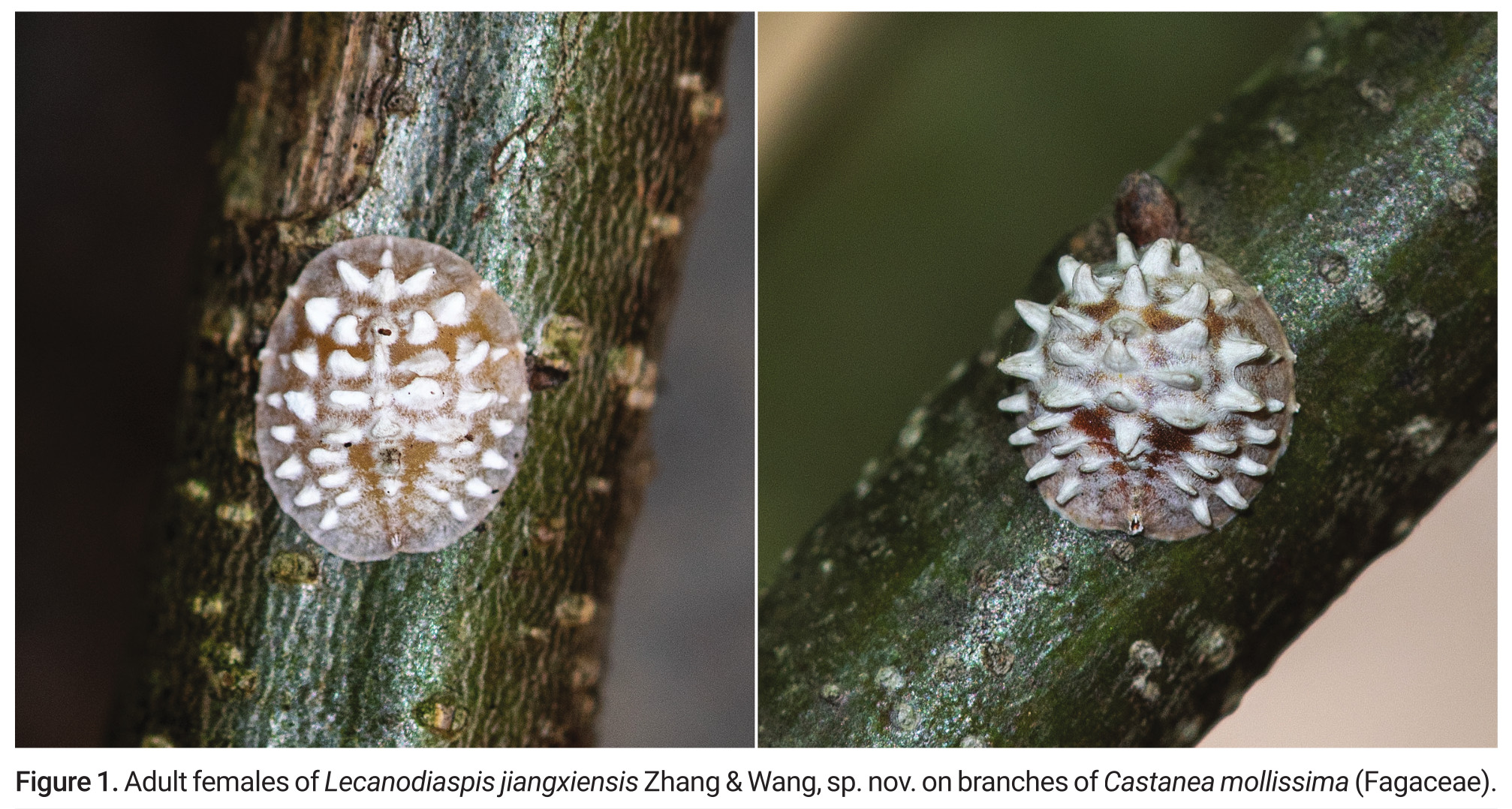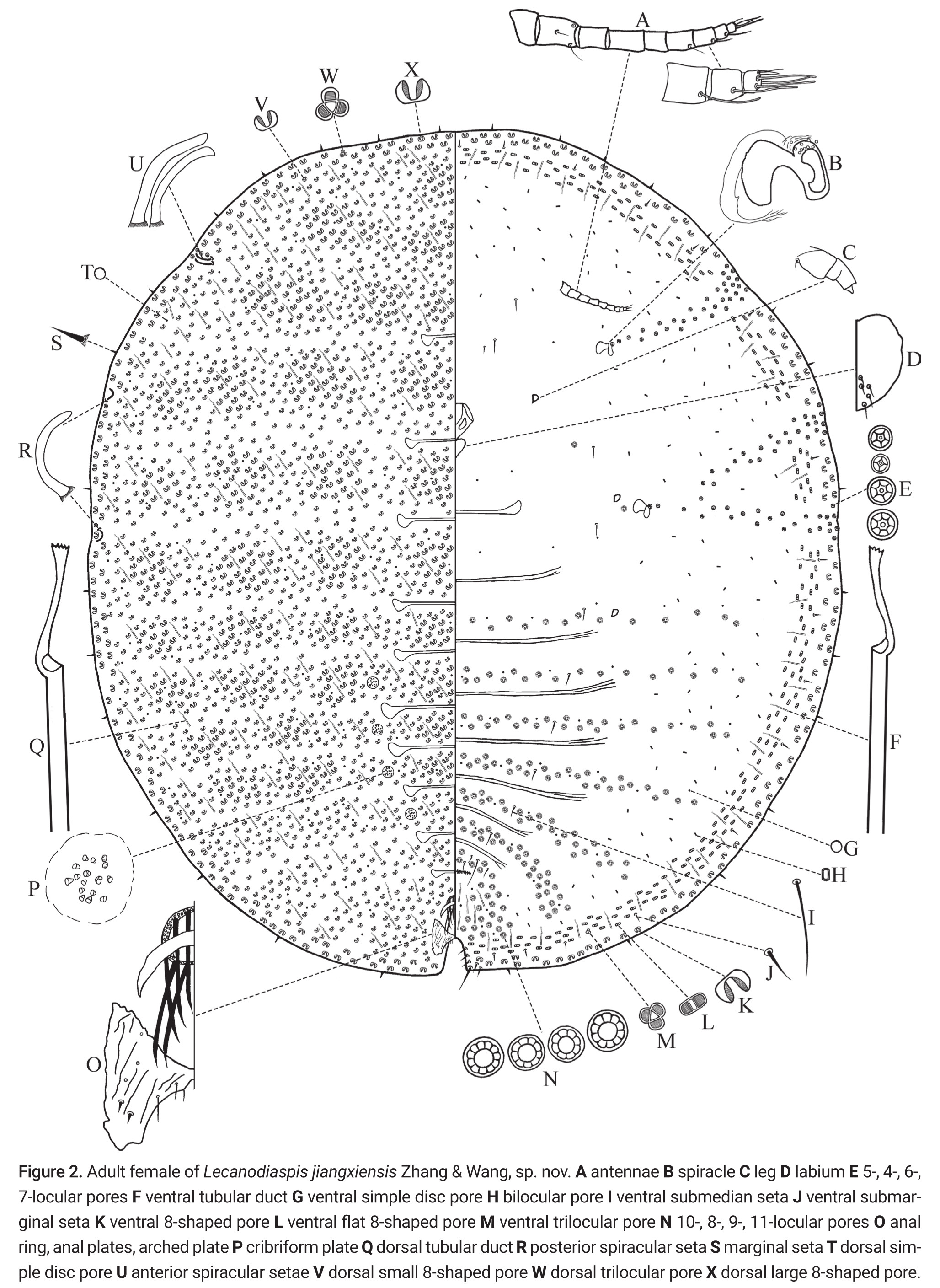Valid Names Results
Lecanodiaspis jiangxiensis Zhang & Wang, 2025 (Lecanodiaspididae: Lecanodiaspis)Nomenclatural History
- Lecanodiaspis jiangxiensis Zhang & Wang 2025: 221. Type data: CHINA: Jiangxi Province, Yichun City, Fengxin County, Zaoxia Town, Niyang Village (28°49'16"N, 115°5'40"E), on branches of Castanea mollissima, 07/13/2022, coll. J. Zhang. Holotype, female, by original designation Type depository: Jiangxi: College of Forestry, Jiangxi Agricultural University, Jiangxi, China.; accepted valid name Notes: Paratypes: same data as holotype (13 ♀ CFJAU, 2 ♀ SWFU) Illustr.
Common Names
Ecological Associates
Hosts:
Families: 1 | Genera: 1
- Fagaceae
- Castanea mollissima | ZhangWaWa2025
Geographic Distribution
Countries: 1
- China
- Jiangxi (=Kiangsi) | ZhangWaWa2025
Keys
- ZhangWaWa2025: pp.227 ( Adult (F) ) [Species of the family Lecanodiaspididae known from China]
Remarks
- Systematics: Lecanodiaspis jiangxiensis is similar to L. pasaniae (Borchsenius, 1960) in having the posterior spiracular furrow branched and in feeding on Fagaceae. However, L. jiangxiensis differs from L. pasaniae (character states for the latter given in parentheses) by having: (i) cribriform plates present in two longitudinal rows (absent); (ii) legs present, three pairs (absent, or only the prothoracic legs present); (iii) terminal antennal segment with three fleshy and three or four slender setae (with ~ three fleshy and six slender setae). (Zhang et al. 2025)
- Structure: Adult female in life: Rounded to oval, slightly to strongly convex (becoming more convex with age), yellow to brownish-yellow. With a longitudinal medial carina between 8–10 short conical projections, and ~ three longitudinal lateral carinae on each side. Slide-mounted female: Body oval to subcircular, 4.05–4.95 mm long and 3.75–4.70 mm wide. Dorsal surface. 8-shaped pores numerous, each pore bent, distributed throughout derm, of two sizes. Trilocular pores occasionally present. Simple disc pores numerous, evenly distributed, each 2–3 μm in diameter. Tubular ducts numerous, evenly distributed, cylindrical, each 27–36 μm long and 3.5–4.0 μm wide. Marginal setae stiff, spine-like and pointed apically, each with a stout basal socket, 12.5–20.0 μm long. Other short setae rare dorsally. Two anterior spiracular setae subequal in size, 67.5–85.0 μm long and 7.5–10.0 μm wide, both appearing somewhat concave and bladelike at apex. Two posterior spiracular setae present singly, with one at each outer end of bifid posterior spiracular furrow. Anal ring elliptical, slightly open at posterior end, 60–75 μm in diameter; bearing 10 long setae (12 setae on one specimen), each seta 142–187 μm long, and with three concentric rows of nipple-like projections. Ventral surface. Antennae well-developed, each usually 9-segmented. Legs reduced, fused and irregularly shaped; each leg usually with one short seta present at base, sometimes leg apices with claw remnants, occasionally tarsal digitules present (found only on 1 hind leg). (Zhang et al. 2025)
- General Remarks: Description, illustration, and color photos by Zhang et al. (2025).
Illustrations
Citations
- ZhangWaWa2025: description, distribution, host, illustration, key, list of species, taxonomy, 227, 230




